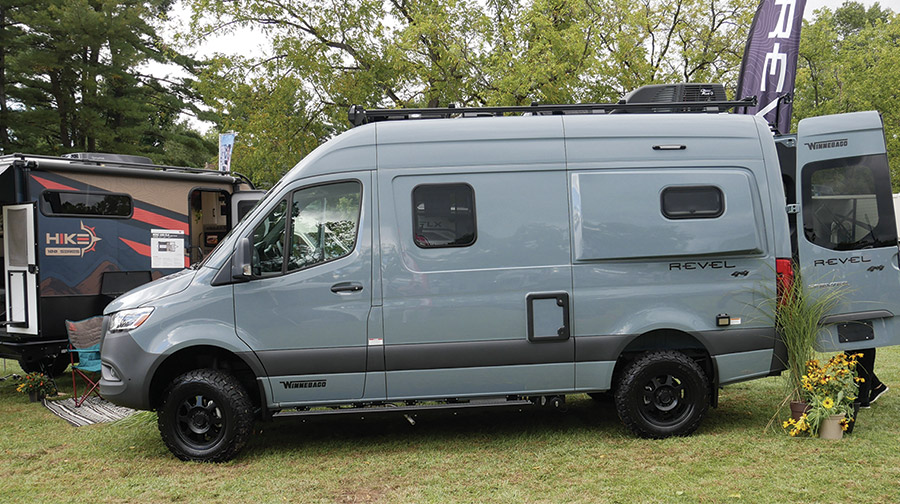istorically, when life pivots in the United States, the RV industry takes it on the chin. However, when the COVID-19 pandemic shut down the country, the industry got lucky — it prospered beyond belief. Getting out in an RV was one of the best ways for people to find relief from the pandemic stresses, and those who embraced RVing were able to enjoy a little chunk of normalcy and stay relatively safe from the bug. And the lifestyle caught on in a big way.
Now we’re faced with new challenges — including one of our old nemeses: fuel. Continued bad news about fuel could send shock waves. Or will it this time? I suppose the answer is a little more complex than a simple “yes” or “no.”
Granted, fuel can have a seriously negative affect on our mental well-being — and our wallets — but it’s best not to get hung up on reading the posted fuel prices at service stations. When you do the math, RV vacations are still more affordable. While I still stand by the premise that fuel prices can be reckoned with — and Europeans proved that years ago — a new fly in the ointment may require some lifestyle adjustments and possibly more practical decisions when enthusiasts select the best RV that fits their needs. An article, “Bottleneck Fuels Record Gas Prices” in the May 28, 2022 issue of the Wall Street Journal (WSJ) was troubling. Fuel prices will likely be impacted by reduced refinery production and a looming ferocious global appetite for fuel as driving routines are normalized and the world climbs out of pandemic shutdowns and restrictions. According to the article in the WSJ , when demand plummeted during the height of the pandemic, older refineries were shuttered. Getting back to normal, if that’s even possible, may be painful. Alas, are we looking at a repeat of the long lines of the early 1970’s? Maybe. The misguided energy policy in this country will undoubtedly continue to fester controversy.

RVers have learned to do more with less, especially in well-though-out floorplans in smaller Class B motorhomes.
Don’t get me wrong; going “green” is a worthy goal. I bought my first electric car six years ago and loved it. But fossil fuels will still be in high demand for many years while technology evolves, thereby making electric vehicles more feasible for heavier-load service — and, of course, as the charging infrastructure continues to expand. I’m not sure how the power grid is going to be able to keep up with demand, considering rolling blackouts are becoming more prevalent in certain areas. It’s like expanding communities without building roadways to handle the uptick in traffic. For now, I’ll defer that argument to the opinion pages.
We should all be concerned with our carbon footprint, and kudos to the RV industry for working toward that goal. Many years ago, I studied how RVs impacted our carbon footprint after attending a symposium on environmental conservation — and the results were eye-opening. The speakers actually touted RVing. Why? Because RVs are greener than most homes. True, RVs consume more fuel on a per-mile basis than the average car, but RVs are not used for commuting. And while fuel consumption is only part of the equation, from a livability standpoint, RVs are the ultimate conservation machines.
Consider, for example, that the average household uses around 300 gallons of water per day. RVers can get along with 50 gallons of water (average) stored in an onboard holding tank for a few days while boondocking — and even when hooked up they still consume much less than a stationary household. Beyond a natural desire to conserve on the part of RVers, the fact remains that it takes less water to flush the toilet and fill up smaller sinks. Then, too, RVs rarely have multiple showerheads to promote lingering — and there’s no outside landscaping to maintain.
Energy conservation is equally as important. The average household consumes around 30 kWh of power on a daily basis, which is about 30% more than RVs when hooked up in an RV park. As more RVers turn to self-containment, employing robust solar systems that make it possible to shun the power grid, the positive impact is greater. And obviously, when a home is vacated during an RV vacation, the power savings are substantial.
Nevertheless, there is still more work to be done. For example, higher profile motorhomes and fifth wheels are more spacious, but are they necessary for most enthusiasts? Probably not if smaller, lighter models are on the horizon; save the extra weight for mandatory dual-pane windows and added insulation. My wife, Lynne, and I live full time in a lower profile fifth wheel with these window and insulation features, and the HVAC efficiency is excellent.
Creative space utilization also makes it possible to live comfortably in less square footage as illustrated by the Class B motorhome segment. And the trend toward all electric systems supported by onboard power grids is breathtaking. The thought of powering an air-conditioner without running a generator or hooking up in an RV park was fantasy just a few years ago. So was towing with an all-electric truck!
I think we’re poised for an evolution in the RV industry. There will always be a market for more conventional RVs — especially for the full-timing crowd — but creating contemporary RVs in response to current events will keep the buzz alive. The concept of living large without the bulk is exciting, and I believe the industry is up to the challenge.

